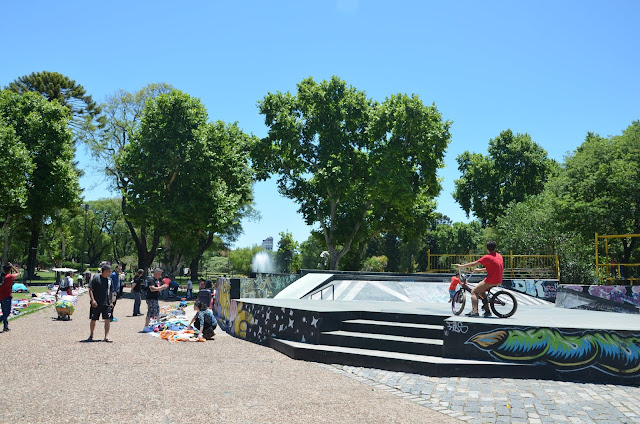On a
Thursday in December, foggy and cold Vienna is once again filled with
protesters, yet again showing their disapproval of the blue-turquoise coalition
in Austria.
At the Plaza de Mayo in
Buenos Aires, as on every Thursday, the
demonstrators of the movement Madras de
Plaza de Mayo meet. The first demonstrations began here on April 30, 1977. Mothers
come who are desperately looking for their children and relatives who disappeared
during the Argentine dictatorship in the 70s and 80s. They have been struggling peacefully up to the
present day to clarify about 30.000 disappearances.
Each peso helps
On a
Saturday afternoon a flea market is being held in the sun-drenched Parque del Centenario in the quarter of Caballito. Porteños put used but still
usable big and little things on their blankets and temporary sales counters.
Children carefully place their old toys in a few regular rows. I read an even-tempered
expression in their young faces. These families are happy about each peso, they
don´t "store" childhood in large mahogany cabinets that are
scrupulously sealed for decades. Their untouched and fragile childhood remains
hidden only in the drawers of their memory.
According
to unofficial data, an unbelievable 50% of the Argentine population, especially
in rural areas, lives on the poverty line. During long evenings and nights
whole families walk through the streets of Buenos Aires with black garbage bags
and barrows. They try to reach for recyclable waste - especially paper and
cardboard - in the big and deep containers. Although collection and subsequent
sorting of garbage brings a regular income to both individuals and families, it
does not replace a real wage.
After the great economic crisis of 2001, the term
Cartoneros began to appear very often
in the media. It describes approximately 25.000 people who live outside the
system and make their living mainly from urban recycling in the capital city of
Argentine. In fact, the system even benefits from these people, as they take on
many of its duties regarding waste management.
Different movie/ Otra película
Affluent
people and tourists enjoy the evening in bars and modern lounges in the hipster
district of Palermo. Well-groomed young people stand in front of the clubs.
Meanwhile the Cartoneros lie in the
nearby side streets on their mattresses. The sceneries of Buenos Aires change
quickly and shock with unprecedented contrasts.
Mariela, a friend of ours, says
that it is nearly like being suddenly placed in a completely different movie - otra película. For example the poorest
unofficial city district of Villa 31 lies
just beside the new and rich neighbourhood of Puerto Madeiro. Did the local people get used to the poverty in the
same way they switch the TV-channels? Both Mariela and her husband Bryan are saddened
by this subject. Even the volunteering activities seem only to increase Bryan´s
frustration. The solution could be long-term investments in education and
special projects in the field of social work.
 |
| Madras de Plaza de Mayo |
 |
| Flea market at Parque del Centenario |
Buenos Aires
Hmlistú a studenú Viedeň
opäť zaplnili protestujúci, vytrvalo vyslovujúci nesúhlas s modro-tyrkysovou
koalíciou v Rakúsku počas tkz. "Štvrtkovej demonštrácie". Na námestí Plaza de Mayo v Buenos Aires sa tak
ako každý štvrtok zišli demonštranti hnutia Madres
de Plaza de Mayo. Prvé demonštrácie začali 30. apríla 1977 matky hľadajúce
svoje deti a príbuzných, ktorí zmizli počas argentínskej diktatúry
v rokoch 1970-1980. Doteraz bezúspešne bojujú za objasnenie približne
30.000 zmiznutí.
Počas sobotňajšieho dňa sa v slnkom zaliatom parku "Parque del Centenario" v štvrti Caballito koná blší trh. Na deky a provizórne predajné pulty miestni Porteños porozkladali nepotrebné, používané ale stále použiteľné veci a vecičky. Deti vedľa seba zamyslene a dôsledne ukladajú staré hračky. V ich predčasne vyspelých tvárach čítam vyrovnaný výraz. Týmto rodinách sa zíde každé pesos. Nenosí sa tu uschovávať detstvo do veľkých mahagónových skríň, ktoré sa niekoľko desaťročí svedomito zapečatia. Ich nedotknuté a krehké detstvo zostáva schované len v pomyselných šuplíkoch.
Až neuveriteľných 50% argentínskej populácie, najmä vo vidieckych oblastiach podľa neoficiálnych údajov žije na hranici chudoby. Počas dlhých večerov a nocí prechádzajú celé rodiny s deťmi po uliciach Buenos Aires s čiernymi odpadkovými vrecami či káričkami. Z hlbokých útrob kontajnerov sa snažia vyloviť recyklovateľný odpad- najmä papier a kartón. Zbieranie a následné triedenie odpadkov prináša jednotlivcom či celým rodinám pravidelný príjem, ktorý však nenahradí normálnu plácu. Po veľkej ekonomickej kríze v roku 2001 sa médiách začal často objavovať pojem "Cartoneros", opisujúci približne 25.000 ľudí žijúcich mimo systému argentínskeho hlavného mesta, živiacich sa najmä urbánnym recyklovaním. Títo ľudia síce žijú mimo systému, prinášajú mu však osoh tým, že preberajú mnohé jeho úlohy.
V hipsterskej štvrti Palermo v baroch a moderných lokáloch posedávajú zámožnejší ľudia i turisti a užívajú si večer. Pred vychytenými barmi postávajú vymódení mladí ľudia. V neďalekých postranných uličkách si zatiaľ líhajú na matrace Cartoneros. Scenérie Buenos Aires sa vedia zmeniť rýchlo a šokujú nevídanými kontrastmi.
Kamarátka Mariela pri týchto radikálnych zmenách prostredia hovorí, že je to ako byť odrazu v "inom filme", je to ako "otra película"- ibaže zakotvená v realite. Napríklad hneď neďaleko novej bohatej štvrte Puerto Madeiro leží najchudobnejšia neoficiálna mestská štvrť Villa 31. Žeby si miestni ľudia na chudobu už zvykli ako na prepínanie televíznych kanálov? Mariela a jej manžel pri tejto téme obaja zosmutnejú. Dobrovoľnícke aktivity, zdá sa, ešte len zvýšili Bryanovu frustráciu. Riešenie by mohli predstavovať dlhodobé investície do vzdelania a špeciálnych projektov v oblasti sociálnej práce.





No comments:
Post a Comment